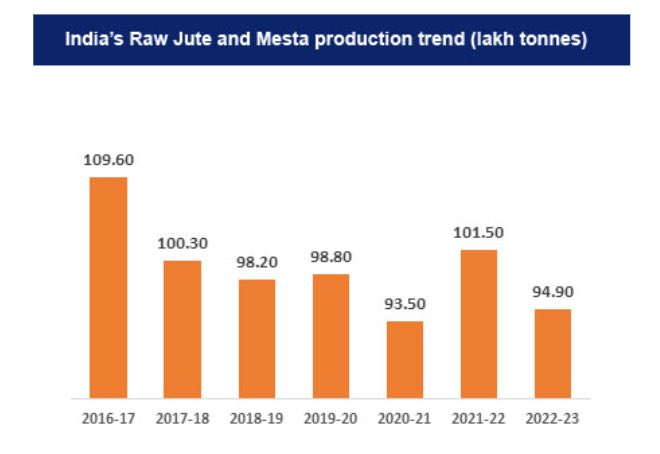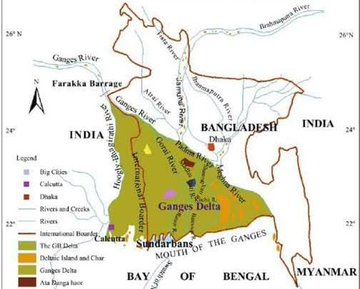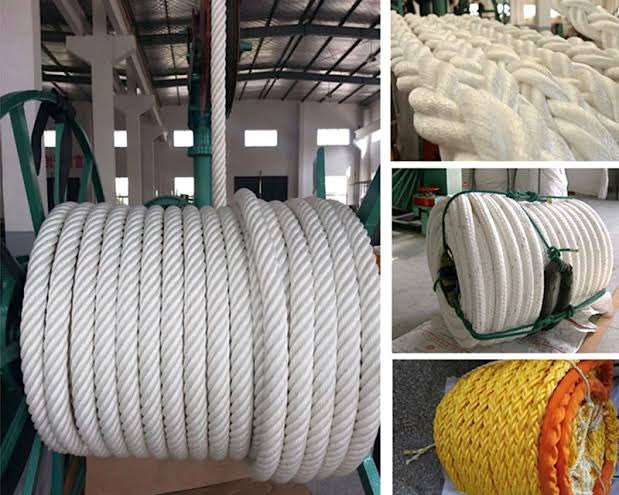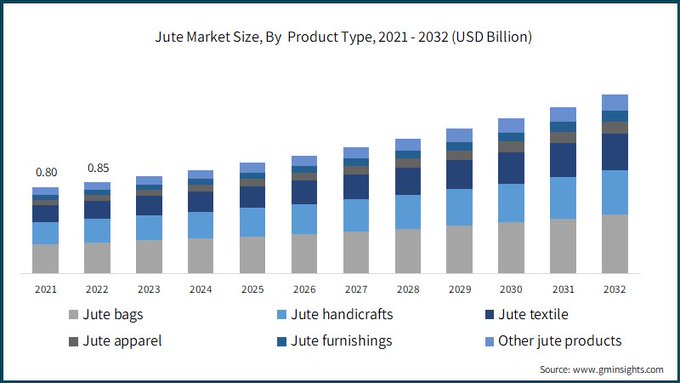V
Vedant Pathak
Guest
In 2014, Prime Minister Narendra Modi expressed concern over India’s heavy reliance on Bangladesh and Nepal for its jute needs, despite being the world’s largest producer of jute. This sparked a determination to break Bangladesh’s monopoly in the jute industry and transform India into a jute superpower.
In the fiscal year 2022-23, India produced 94.90 lakh tonnes of Raw Jute & Mesta, two closely related crops. Additionally, the country produced 384.1 lakh tonnes of finished jute products, accounting for 75% of the global production. The country’s substantial demand for jute highlights that nearly 90% of this production was consumed domestically, interestingly.

PC – RBI Handbook of Statitistics
Jute cultivation in the Indian subcontinent has a rich history, dating back to ancient times. Known as “the golden fiber,” jute emerged as a significant cash crop during the British colonial period. The fertile soil and favorable climate of the Ganges delta provided ideal conditions for jute cultivation.

The Fertile soil and favorable climate of the Ganges delta
Jute fibers, naturally robust and versatile, excel in containing and moving heavy industrial materials. Recognizing the potential of jute, the British declared it a valuable commodity and promoted its large-scale cultivation. Industrialization’s arrival in the 19th century spurred the establishment of jute mills in East and West Bengal for processing.
Despite its historical significance and potential, the Indian jute industry has faced numerous challenges since the beginning of the 20th century. The primary threat has emerged from Bangladesh due to several factors:
These factors have enabled Bangladesh to produce superior quality raw jute and products at a much lower price, making it the world’s leading jute exporter.
In addition to facing stiff competition in the global market, India’s jute industry has been grappling with other challenges such as obsolete technology in many jute mills and the adoption of synthetic substitutes like polypropylene and nylon. These substitutes offer increased durability and water resistance at a lower cost, making them more appealing to consumers. As a result, India’s jute production reduced significantly in 2022-23.

Despite these challenges, the Indian government is undertaking significant measures to revitalize the jute industry. This is crucial as the industry supports over 40 lakh farm families and provides employment to more than 5 lakh industrial workers. They have low wages, lack of job security, and limited access to basic amenities like clean water & sanitation facilities.

Jute Market Size | PC – gminsights.com
More countries are adopting Jute sacks and other jute products. Countries like Ghana, whose economy is dependent on Cocoa harvesting and production, are importing more jute sacks.

Jute Bag Market Size | PC – businessresearchinsights

In 2021, the Ministry of Textiles announced an Umbrella Scheme of the National Jute Board for the Development & Promotion of the Jute Sector — the National Jute Development Program (NJDP). With a total outlay of ₹485 Cr for implementation during 2021-26, the NJDP comprises various sub-schemes:
In 2017, India imposed anti-dumping duties ranging from $19 to $352 on certain jute products being imported from Bangladesh and Nepal for a five-year period to protect the domestic jute industry. Despite this, continued dumping of these products has led to an extension of the duties for another five years.
In 2023-24, the Minimum Support Price (MSP) of raw jute has been increased to ₹5050/quintal from ₹4750/quintal in 2022-23, ensuring a minimum of 50% as a margin of profit for jute growers.
With these measures and initiatives, India is steadily paving its way towards becoming a jute superpower, overcoming challenges and capitalizing on the immense potential of the jute industry. The journey is challenging, but the potential rewards for the economy and the environment make it a worthwhile endeavor.
The post India ’s Journey to Becoming a Jute Superpower appeared first on The Jaipur Dialogues.
Continue reading...
India’s Jute Production
In the fiscal year 2022-23, India produced 94.90 lakh tonnes of Raw Jute & Mesta, two closely related crops. Additionally, the country produced 384.1 lakh tonnes of finished jute products, accounting for 75% of the global production. The country’s substantial demand for jute highlights that nearly 90% of this production was consumed domestically, interestingly.

PC – RBI Handbook of Statitistics
The Historical Significance of Jute in India
Jute cultivation in the Indian subcontinent has a rich history, dating back to ancient times. Known as “the golden fiber,” jute emerged as a significant cash crop during the British colonial period. The fertile soil and favorable climate of the Ganges delta provided ideal conditions for jute cultivation.

The Fertile soil and favorable climate of the Ganges delta
Jute fibers, naturally robust and versatile, excel in containing and moving heavy industrial materials. Recognizing the potential of jute, the British declared it a valuable commodity and promoted its large-scale cultivation. Industrialization’s arrival in the 19th century spurred the establishment of jute mills in East and West Bengal for processing.
Challenges Faced by the Indian Jute Industry
Despite its historical significance and potential, the Indian jute industry has faced numerous challenges since the beginning of the 20th century. The primary threat has emerged from Bangladesh due to several factors:
- Partition: The partition of Bengal resulted in East Bengal, later known as East Pakistan and then Bangladesh, inheriting a significant portion of the established jute industry, including major jute mills and most of the productive area under cultivation.
- Superior Quality Product: Bangladesh’s agro-climatic conditions, characterized by heavier rainfall than India, are more conducive to the retting process, a crucial step in jute production that involves submerging raw jute stems in water to separate the loosened fibers from the stalk.
- Low Cost of Production: Bangladesh has managed to lower its production cost by specializing in jute production and processing, aided by better infrastructure, technological adoption, and skilled labor.
These factors have enabled Bangladesh to produce superior quality raw jute and products at a much lower price, making it the world’s leading jute exporter.
In addition to facing stiff competition in the global market, India’s jute industry has been grappling with other challenges such as obsolete technology in many jute mills and the adoption of synthetic substitutes like polypropylene and nylon. These substitutes offer increased durability and water resistance at a lower cost, making them more appealing to consumers. As a result, India’s jute production reduced significantly in 2022-23.

The Road Ahead
Despite these challenges, the Indian government is undertaking significant measures to revitalize the jute industry. This is crucial as the industry supports over 40 lakh farm families and provides employment to more than 5 lakh industrial workers. They have low wages, lack of job security, and limited access to basic amenities like clean water & sanitation facilities.

Jute Market Size | PC – gminsights.com
Secondly, the jute industry has a lot of potential due to the global shift towards sustainable practices. The global jute market is projected to expand fourfold by 2031.
More countries are adopting Jute sacks and other jute products. Countries like Ghana, whose economy is dependent on Cocoa harvesting and production, are importing more jute sacks.

Jute Bag Market Size | PC – businessresearchinsights

Government Initiatives to Boost the Jute Industry
In 2021, the Ministry of Textiles announced an Umbrella Scheme of the National Jute Board for the Development & Promotion of the Jute Sector — the National Jute Development Program (NJDP). With a total outlay of ₹485 Cr for implementation during 2021-26, the NJDP comprises various sub-schemes:
- Jute Raw Material Bank (JRMB): This scheme ensures the continuous supply and sale of raw materials. JRMB directly sources raw materials from certified jute mills and manufacturers at cost-effective rates.
- Product Diversification Scheme: The goal of this scheme is to identify unique jute-based products with high potential. It invites proposals from various organizations, including IITs and NIDs.
- Capital Subsidy for Acquisition of Plants and Machinery (CSAPM) for Jute Diversified Products (JDPs): The CSAPM scheme offers a 30% incentive on the cost of eligible machinery/equipment acquired and installed for modernization and/or upgrading to MSME JDP units.
- Scholarship Scheme for Girl Children of Workers of Jute Mills/MSME JDP Units: Under this scheme, girl children of workers of jute mills are provided with a scholarship of ₹5,000 for secondary education and ₹10,000 for higher secondary education.
- Market Development & Promotion Scheme (MDPS): The MDPS scheme aims to develop and expand markets for jute products domestically and internationally. It provides platforms for selling, marketing, and promoting jute products to various stakeholders, including artisans, entrepreneurs, and millers.
Measures to Protect the Domestic Jute Industry
In 2017, India imposed anti-dumping duties ranging from $19 to $352 on certain jute products being imported from Bangladesh and Nepal for a five-year period to protect the domestic jute industry. Despite this, continued dumping of these products has led to an extension of the duties for another five years.
In 2023-24, the Minimum Support Price (MSP) of raw jute has been increased to ₹5050/quintal from ₹4750/quintal in 2022-23, ensuring a minimum of 50% as a margin of profit for jute growers.
With these measures and initiatives, India is steadily paving its way towards becoming a jute superpower, overcoming challenges and capitalizing on the immense potential of the jute industry. The journey is challenging, but the potential rewards for the economy and the environment make it a worthwhile endeavor.
The post India ’s Journey to Becoming a Jute Superpower appeared first on The Jaipur Dialogues.
Continue reading...
